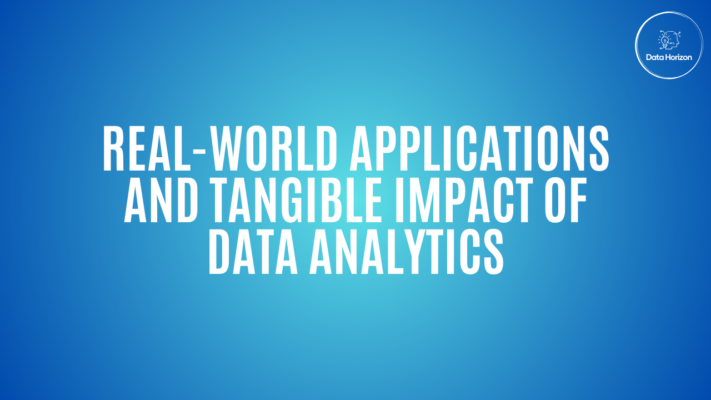In continuation of our preceding blog post titled “Introduction to Data Analytics and its Impact on Modern Business” wherein we elucidated the foundational theoretical frameworks of Data Analytics, we now pivot our focus towards a practical exploration. Let us delve into real-world applications and manifestations of data analytics in contemporary business scenarios.
Empirical Evidence: Data Analytics in Action
While theoretical frameworks and conceptual paradigms provide foundational insights, the true value proposition of data analytics crystallizes through real-world applications, tangible outcomes, and empirical evidence. Across industries, sectors, and organizational contexts, data analytics catalyzes innovation, optimizes operations, and fosters sustainable growth. Let’s elucidate its transformative impact through illustrative examples and case studies.
1. Retail and Consumer Goods: Optimizing Customer Experiences and Demand Forecasting
In the hyper-competitive retail landscape, understanding consumer preferences, behaviors, and purchasing patterns is paramount. Leveraging data analytics, leading retailers harness vast datasets—from transaction histories and loyalty programs to social media interactions and online behaviors—to craft personalized experiences, refine product assortments, and optimize pricing strategies.
For instance, renowned e-commerce platforms employ machine learning algorithms and predictive analytics to recommend products, tailor marketing campaigns, and forecast demand fluctuations. By analyzing historical sales data, customer reviews, and market trends, retailers optimize inventory management, mitigate stockouts, and capitalize on emerging opportunities, fostering agility, resilience, and competitive differentiation.
2. Healthcare and Life Sciences: Enhancing Patient Outcomes and Treatment Modalities
In the healthcare landscape, data analytics transcends administrative efficiencies, underpinning clinical decision-making, patient care, and medical innovation. Leveraging electronic health records (EHRs), genomic data, and real-time monitoring systems, healthcare providers harness predictive analytics and artificial intelligence (AI) algorithms to diagnose diseases, personalize treatment modalities, and optimize healthcare delivery.
For instance, pioneering healthcare organizations employ predictive models to identify at-risk patient populations, stratify disease progression trajectories, and optimize resource allocation. By analyzing patient demographics, medical histories, and treatment outcomes, healthcare providers enhance patient outcomes, reduce readmission rates, and foster holistic, patient-centric care paradigms.
3. Financial Services: Mitigating Risks and Driving Strategic Growth
Within the financial services sector, data analytics serves as a linchpin, informing risk management, regulatory compliance, and strategic growth initiatives. By analyzing transactional data, market trends, and macroeconomic indicators, financial institutions harness predictive analytics, machine learning algorithms, and advanced modeling techniques to quantify risks, optimize capital allocation, and foster sustainable growth.
For instance, leading banks employ anomaly detection algorithms to identify fraudulent activities, mitigate financial risks, and safeguard customer assets. By analyzing transaction patterns, user behaviors, and historical fraud instances, financial institutions enhance security protocols, foster customer trust, and navigate regulatory landscapes, ensuring compliance, integrity, and resilience.
4. Manufacturing and Supply Chain: Optimizing Operations and Resource Utilization
In the manufacturing and supply chain domains, data analytics underpins operational efficiencies, resource utilization, and supply chain orchestration. By analyzing production metrics, inventory levels, and logistical constraints, manufacturing entities harness prescriptive analytics, optimization algorithms, and simulation models to streamline operations, mitigate disruptions, and enhance productivity.
For instance, leading manufacturers employ demand forecasting models to anticipate market dynamics, optimize production schedules, and mitigate stockouts or overstock situations. By analyzing sales forecasts, production capacities, and supply chain constraints, manufacturing entities foster agility, responsiveness, and operational excellence, ensuring alignment with market demands, customer expectations, and industry benchmarks.
Conclusion
As illustrated through diverse industry examples and contexts, data analytics transcends theoretical constructs, offering tangible, actionable insights, and transformative outcomes. Whether optimizing customer experiences, enhancing patient outcomes, mitigating financial risks, or streamlining supply chain operations, data analytics serves as a catalyst, fostering innovation, resilience, and strategic differentiation. As businesses navigate evolving landscapes, competitive pressures, and digital disruptions, embracing data analytics emerges not as an option but an imperative, ensuring sustainable growth, competitive advantage, and organizational excellence in an increasingly complex, interconnected, and data-driven world.
Thank you for embarking on this analytical odyssey with us. As we conclude this segment, stay tuned for subsequent posts, delving deeper into tools, technologies, best practices, and emerging trends, ensuring organizations harness the full spectrum of data analytics capabilities, opportunities, and advantages.
